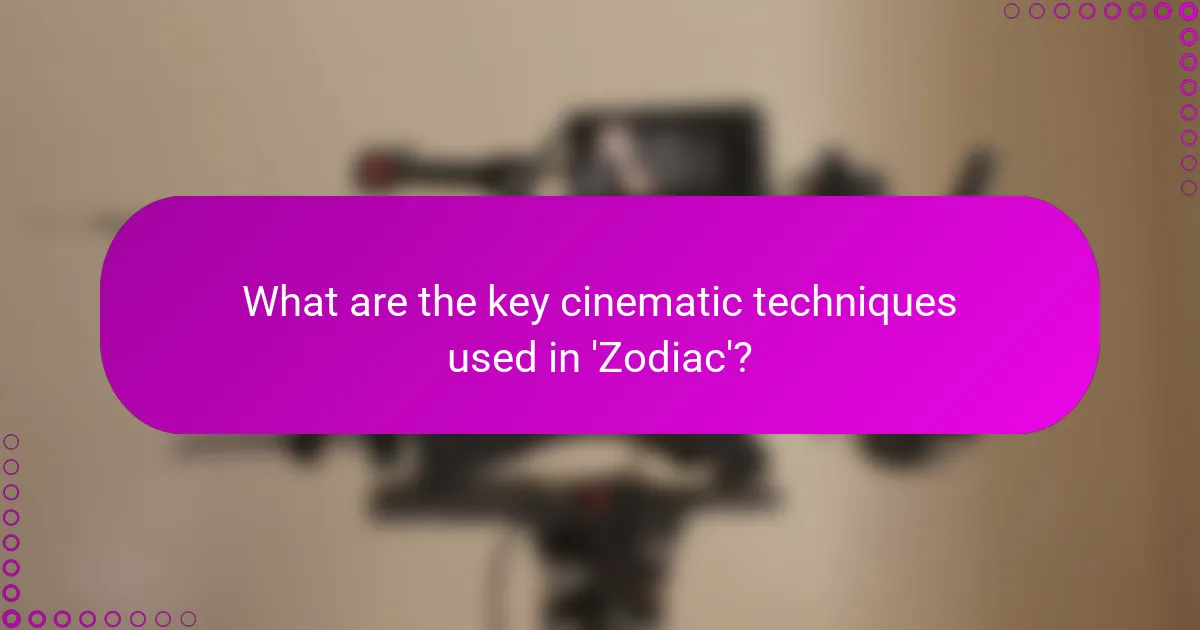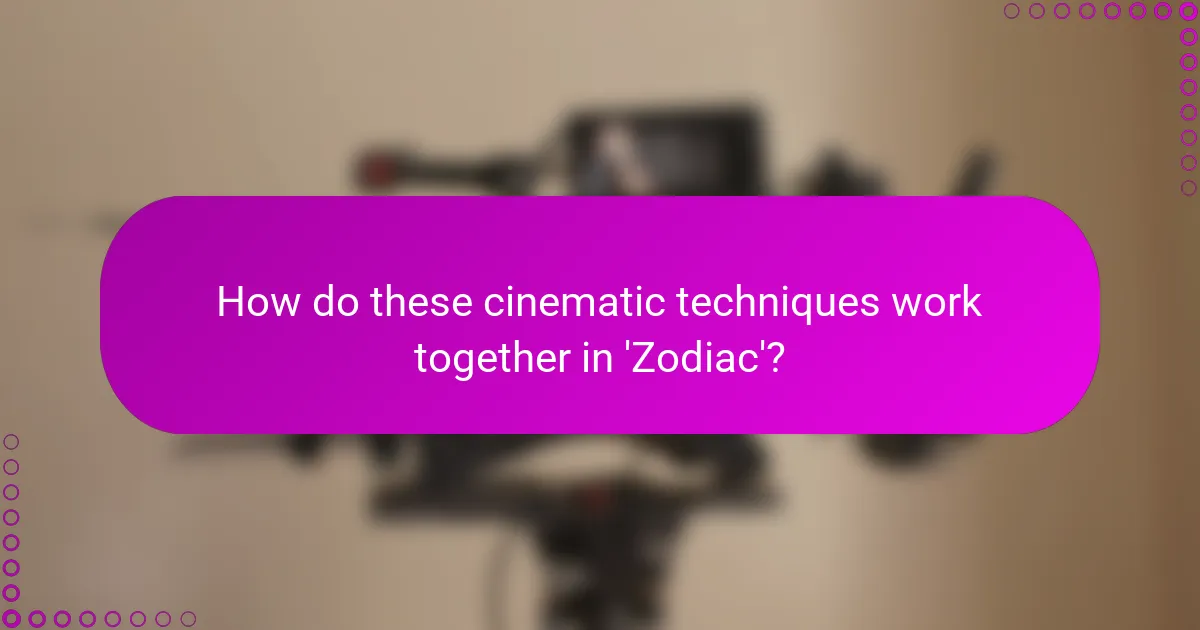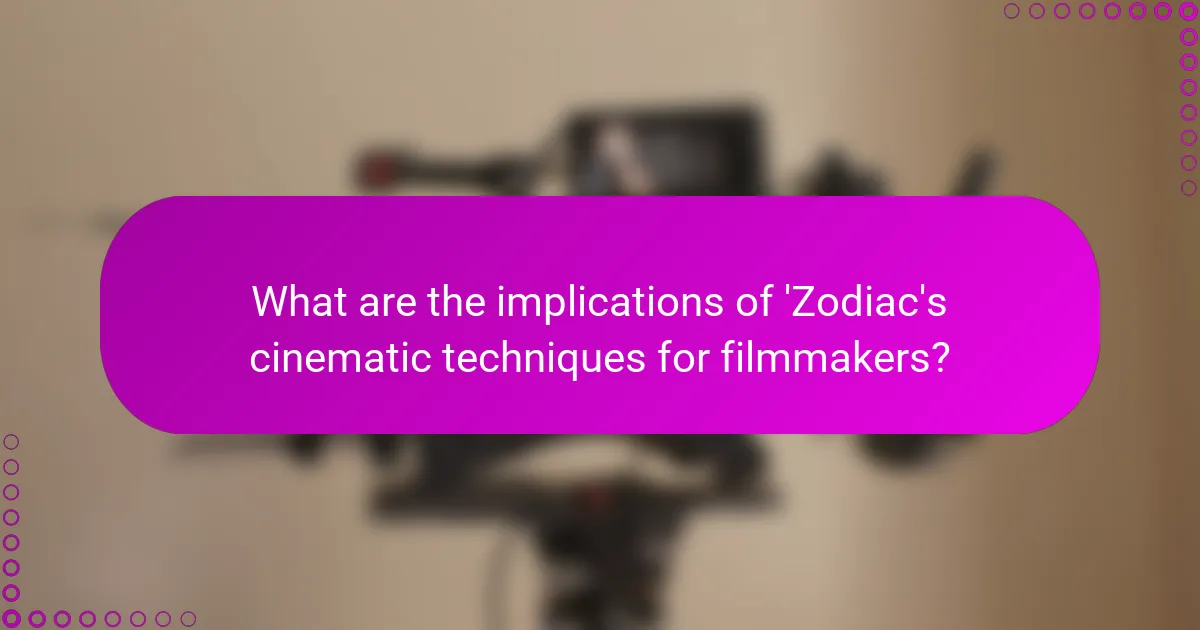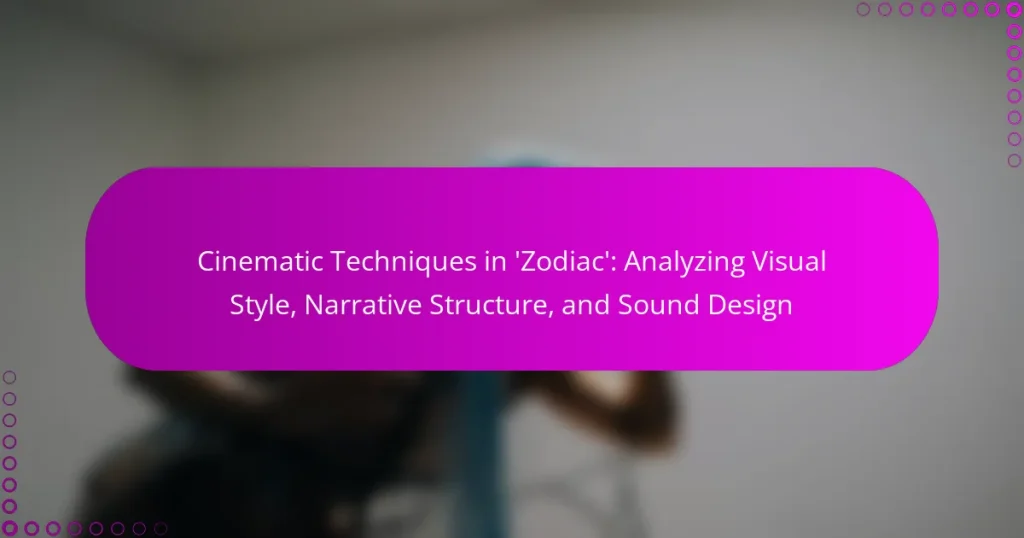The article analyzes the cinematic techniques used in the film ‘Zodiac,’ focusing on its visual style, narrative structure, and sound design. Key elements include meticulous mise-en-scène that captures period authenticity, a non-linear narrative structure that enhances suspense, and distinctive sound design that elevates emotional impact. The film’s attention to detail in lighting and cinematography fosters realism and engages viewers, while its innovative storytelling challenges conventional filmmaking approaches. These techniques collectively contribute to the film’s exploration of themes such as obsession and the elusive nature of truth, influencing contemporary filmmakers to prioritize authenticity and emotional depth in their work.

What are the key cinematic techniques used in ‘Zodiac’?
The key cinematic techniques used in ‘Zodiac’ include meticulous mise-en-scène, non-linear narrative structure, and distinctive sound design. Mise-en-scène in ‘Zodiac’ is characterized by period authenticity, detailed set designs, and precise framing. This creates an immersive atmosphere reflective of the 1960s and 1970s. The film employs a non-linear narrative structure, presenting events out of chronological order. This technique enhances suspense and mirrors the complexity of the investigation. Sound design plays a crucial role, utilizing ambient noises and a haunting score. The sound complements the visual elements, heightening tension and emotional impact. Collectively, these techniques contribute to the film’s unique storytelling and atmospheric depth.
How does visual style contribute to the storytelling in ‘Zodiac’?
Visual style significantly enhances the storytelling in ‘Zodiac’ through its meticulous use of color, composition, and lighting. The film employs a muted color palette that reflects the bleakness of the narrative. This choice creates a sense of foreboding and tension throughout the story. Additionally, the use of period-specific visuals immerses the audience in the 1970s setting. Cinematographer Harris Savides utilizes precise framing to convey characters’ isolation and obsession. The interplay of shadows and light emphasizes the dark themes of the narrative. Overall, the visual style reinforces the film’s exploration of mystery and the psychological impact of the Zodiac killer on society.
What specific cinematographic choices enhance the film’s atmosphere?
Cinematographic choices that enhance the film’s atmosphere include lighting, camera angles, and composition. The use of low-key lighting creates a sense of tension and unease. This technique emphasizes shadows and obscures details, aligning with the film’s themes of mystery. Camera angles, such as low-angle shots, convey power dynamics and heighten suspense. Additionally, the framing of scenes often isolates characters, underscoring their emotional states. The color palette, dominated by muted tones, reinforces a somber mood. These choices collectively immerse viewers in the film’s unsettling narrative. The effectiveness of these techniques is supported by critical analyses highlighting their impact on audience perception.
How does color grading influence the emotional tone of ‘Zodiac’?
Color grading significantly shapes the emotional tone of ‘Zodiac’. It establishes a moody atmosphere that reflects the film’s themes of obsession and fear. The use of desaturated colors enhances feelings of unease and tension. Warmer tones during certain scenes evoke nostalgia and human connection. Conversely, cooler tones create a sense of detachment and isolation. The color palette aligns with the psychological states of characters. For example, darker hues accompany intense moments, amplifying suspense. Overall, color grading is a crucial element in conveying the film’s complex emotional landscape.
What narrative structures are present in ‘Zodiac’?
‘Zodiac’ employs a non-linear narrative structure. This structure includes multiple timelines that intertwine. The film shifts between different perspectives of characters. It highlights the investigation process through various points of view. The narrative also incorporates real historical events and figures. This blending of fact and fiction enhances its complexity. The use of fragmented storytelling reflects the mystery of the Zodiac case. Each character’s storyline contributes to the overarching theme of obsession.
How does the non-linear storytelling affect audience engagement?
Non-linear storytelling enhances audience engagement by creating intrigue and encouraging active participation. This narrative structure allows viewers to piece together the story from various timelines and perspectives. As a result, audiences become more invested in uncovering connections and meanings. Research shows that non-linear narratives can lead to increased emotional responses, as they often mirror the complexities of real-life experiences. A study by M. J. McKee and R. J. McKee found that engaging with non-linear stories can improve memory retention and satisfaction among viewers. This style prompts discussions and interpretations, fostering a deeper connection to the material.
What role do character arcs play in the film’s narrative development?
Character arcs are essential for driving the narrative development in films. They provide a framework for character growth and transformation throughout the story. As characters face challenges, their responses reveal deeper themes and conflicts. This evolution often reflects the central message of the film. In “Zodiac,” for instance, the character arcs of investigative journalists showcase the obsession and toll of seeking truth. Their journeys illustrate the impact of unresolved mysteries on personal lives. This connection between character arcs and narrative progression enhances audience engagement and emotional investment. Thus, character arcs are pivotal in shaping the overall storytelling experience.
How is sound design utilized to create tension in ‘Zodiac’?
Sound design in ‘Zodiac’ is utilized to create tension through the strategic use of ambient noise and unsettling soundscapes. The film employs low-frequency sounds to evoke a sense of dread. Sudden, jarring noises punctuate scenes to heighten anxiety. Silence is also effectively used, making moments of sound more impactful. The layering of sound effects builds an immersive atmosphere. Specific scenes feature distant sirens and unsettling whispers to enhance unease. This combination of elements keeps viewers on edge throughout the narrative. Sound design thus plays a crucial role in amplifying the film’s psychological tension.
What techniques are used to enhance the auditory experience?
Techniques used to enhance the auditory experience include sound design, music scoring, and audio mixing. Sound design creates immersive environments through effects and spatial audio. Music scoring establishes emotional tones and supports the narrative. Audio mixing balances dialogue, sound effects, and music to ensure clarity. In ‘Zodiac’, these techniques contribute to tension and atmosphere, enhancing viewer engagement. The film’s sound design features realistic ambient sounds that ground the story. Music, composed by David Shire, intensifies key moments, guiding audience emotions. Effective audio mixing ensures that critical dialogue remains clear amid layered soundscapes. These combined elements create a rich auditory experience that complements the visual storytelling.
How does the score contribute to the film’s overall impact?
The score significantly enhances the film’s overall impact by creating emotional resonance. It establishes mood and tension throughout key scenes. The music complements the narrative’s pacing and builds suspense. For instance, the haunting melodies underscore the psychological themes of obsession and fear. This use of score aligns with the film’s exploration of the Zodiac killer’s chilling presence. Additionally, the score’s dissonance reflects the uncertainty and chaos of the narrative. Studies show that effective film scores can elevate audience engagement and emotional response. In ‘Zodiac’, the score effectively deepens viewers’ connection to the characters and story.

How do these cinematic techniques work together in ‘Zodiac’?
Cinematic techniques in ‘Zodiac’ work together to create a cohesive narrative and immersive experience. The use of lighting establishes mood and tension, often reflecting the psychological state of characters. Cinematography employs a meticulous framing style, enhancing the film’s sense of realism. The narrative structure unfolds through a non-linear timeline, building suspense and complexity. Sound design incorporates ambient sounds and score to heighten emotional impact. These elements combine to reflect the themes of obsession and the elusive nature of truth. For instance, the film’s meticulous attention to detail mirrors the investigative process, drawing viewers into the story.
What is the relationship between visual style and narrative structure?
Visual style and narrative structure are interconnected elements in filmmaking. Visual style refers to the aesthetic choices made in cinematography, color, and composition. Narrative structure involves the arrangement of events and character arcs within a story. The visual style can enhance or reflect the themes presented in the narrative. For instance, a dark, moody visual style can underscore tension in a suspenseful narrative. Conversely, a bright, vibrant visual style may support a lighter, more optimistic storyline. In ‘Zodiac’, the film’s visual style contributes to the unfolding mystery, guiding the audience’s emotional response. This relationship is evident as the visual choices align with the pacing and tone of the narrative, creating a cohesive cinematic experience.
How does sound design complement visual elements in the film?
Sound design complements visual elements in film by enhancing emotional engagement and narrative depth. It creates an immersive experience that aligns with the visuals. For example, ambient sounds can establish mood, while sound effects emphasize visual actions. In ‘Zodiac’, the interplay of sound and visuals builds tension and suspense. The use of silence can heighten the impact of visual moments. Research shows that sound influences audience perception and interpretation of visuals. This synergy between sound and visuals is crucial for storytelling effectiveness.

What are the implications of ‘Zodiac’s cinematic techniques for filmmakers?
‘Zodiac’s cinematic techniques significantly influence filmmakers by showcasing advanced narrative structures and visual storytelling. The film employs a meticulous attention to detail, enhancing realism and audience engagement. Techniques such as period-accurate production design immerse viewers in the 1970s setting. The use of naturalistic lighting creates an authentic atmosphere, fostering emotional connections. Its non-linear narrative challenges conventional storytelling, encouraging filmmakers to experiment with structure. The sound design amplifies tension, demonstrating the power of audio in building suspense. These elements collectively inspire filmmakers to prioritize authenticity, innovation, and emotional depth in their projects.
What lessons can emerging filmmakers learn from ‘Zodiac’?
Emerging filmmakers can learn the importance of meticulous attention to detail from ‘Zodiac’. The film showcases how precision in storytelling enhances narrative engagement. It employs a non-linear narrative structure that builds suspense over time. This technique encourages filmmakers to explore complex storytelling methods. Additionally, ‘Zodiac’ utilizes atmospheric sound design to evoke emotion and tension. Filmmakers should recognize the power of sound in shaping audience experience. The film also demonstrates the significance of character development and realism. By focusing on authentic portrayals, filmmakers can create relatable narratives. Overall, ‘Zodiac’ serves as a case study in blending visual style with narrative depth.
How can visual style be effectively integrated into narrative filmmaking?
Visual style can be effectively integrated into narrative filmmaking by aligning visual elements with the story’s themes and emotions. This involves using color palettes, lighting, and composition to enhance the narrative. For instance, a dark color scheme can evoke a sense of dread, while bright colors may signify hope or joy. Cinematography techniques, such as camera angles and movement, can also influence the viewer’s perception of characters and events. Historical context supports this, as films like “Zodiac” utilize visual style to reflect the psychological tension of the narrative. The film’s muted tones and meticulous framing enhance the themes of obsession and fear, demonstrating the successful integration of visual style into storytelling.
What best practices in sound design can be derived from ‘Zodiac’?
Best practices in sound design derived from ‘Zodiac’ include the use of ambient soundscapes to enhance tension. The film employs subtle background noises to create an immersive atmosphere. This technique draws the audience into the psychological state of the characters. Additionally, ‘Zodiac’ utilizes silence strategically to heighten suspense. Moments of quiet amplify the impact of sudden sounds. The film also features a meticulous layering of sound effects. This approach adds depth and realism to scenes. Finally, the integration of music is carefully timed to support the narrative. The score complements key moments without overpowering dialogue. These practices contribute to the overall effectiveness of sound design in the film.
How can understanding these techniques enhance film analysis?
Understanding cinematic techniques enhances film analysis by providing deeper insights into storytelling. Techniques like visual style, narrative structure, and sound design shape audience perception. For instance, the use of lighting affects mood and tone. Analyzing camera angles reveals character relationships and perspectives. Sound design influences emotional responses and tension. Recognizing these elements allows for a more comprehensive evaluation of a film’s impact. Understanding these techniques leads to enhanced appreciation of the director’s artistic choices. This knowledge also fosters critical discussions about themes and messages conveyed in the film.
The main entity of the article is the film “Zodiac,” which is analyzed through its key cinematic techniques, including visual style, narrative structure, and sound design. The article explores how mise-en-scène, non-linear storytelling, and sound elements contribute to the film’s immersive atmosphere and thematic depth. It discusses the impact of visual choices, such as color grading and composition, on audience engagement and emotional tone. Additionally, the article examines the role of character arcs and sound design in enhancing tension and narrative complexity, providing insights for filmmakers and film analysis.


